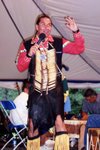Sunday, June 24, 2007
Who Told You
Who told you you can only belong to one American Indian Tribe? I am an enrolled member of the Blackfeet Tribe, but my Dad is Cree, and I am also Gros Vent re. My kids are enrolled in the Haida Tlingit Corporation, but they are also Blackfeet, Cree, Gros Vent re, and cannot qualify to be enrolled in a recognized American Indian Tribe. However, my kids were raised on the Blackfeet Indian reservation and they identify with and claim the Blackfeet tribe as their heritage. As a Tribal member I have always taught my kids that they are Blackfeet, and as my children, they can lay claim to their cultural heritage. We as Indian people have been duped into discriminating against our own people. Our ancestors would never cut their children or grandchildren from their heritage because of blood quanta. In the early days of drafting our tribal constitution our leaders innocently bought into blood quantum requirements for enrollment, and institutionalized the one tribe requirement. This requirement was done ignorantly by tribal leaders in order to protect tribal sovereignty. What they did not realize was that down through the years tribal mixing would become a common occurrence. Their original fears became obsolete as blood quantum requirements and the one tribe policy became threats to tribal populations. It has been statistically proven that eight out of ten American Indians are of mixed blood, and in the near future nine out of ten will be of mixed blood. Its a fact of life we must deal with. When are we going to wake up and understand that blood quantum and one tribe requirements were a part of the assimilation effort to get rid of Indian reservations. In todays world what is going to protect tribal sovereignty is increasing and large populations. We must compete with other minorities and growing immigrations populations. Numbers and votes are what will get attention. Power comes from larger tribal roles protected by language, borders, tradtons and culture.
Blood Quanta
Intertribal and interracial mixing was common among Native American tribes making it difficult to clearly identify which tribe an individual belonged to. Bands or entire tribes occasionally split or merged to form more viable groups in reaction to the pressures of climate, disease and warfare. A number of tribes practiced the adoption of captives into their group to replace their members who had been captured or killed in battle. These captives came from rival tribes and later from European settlers. Some tribes also sheltered or adopted white traders and runaway slaves and Native American-owned slaves. So a number of paths to genetic mixing existed.
In later years, such mixing, however, proved an obstacle to qualifying for recognition and assistance from the U.S. federal government or for tribal money and services. To receive such support, Native Americans must belong to and be certified by a recognized tribal entity. This has taken a number of different forms as each tribal government makes its own rules while the federal government has its own set of standards. In many cases, qualification is based upon the percentage of Native American blood, or the "blood quanta" identified in an individual seeking recognition. To attain such certainty, some tribes have begun requiring genetic genealogy (DNA testing).[28]. Requirements for tribal certification vary widely. The Cherokee require only a descent from an Native American listed on the early 20th century Dawes Rolls while federal scholarships require enrollment in a federally recognized tribe as well as a Certificate of Degree of Indian Blood card showing at least a one-quarter Native American descent. Tribal rules regarding recognition of members with Native American blood from multiple tribes are equally diverse and complex. Wikipedia.com/American Indian/Blood Quanta
Subscribe to:
Posts (Atom)
